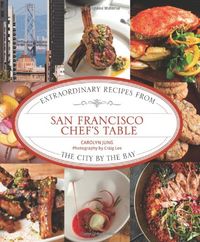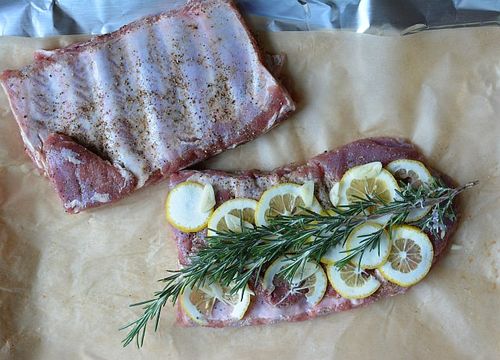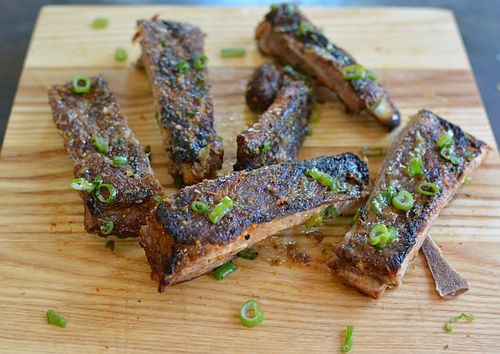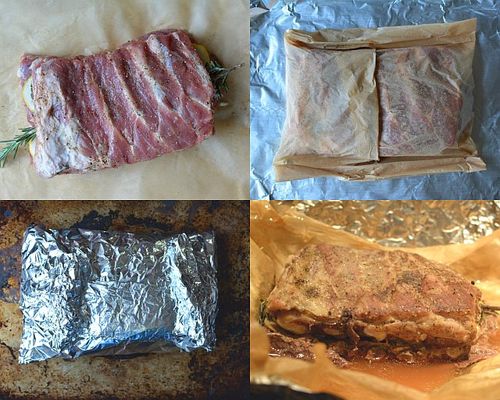My friend Cuong Pham, the founder and owner of Red Boat fish sauce, came to dinner with his family a few weeks ago. One of the first things he mentioned was that they’d celebrated their daughter’s birthday the night before at State Bird Provisions in San Francisco. “You got in?” I asked, telling him that one time we arrived around 6pm and the line was 3 hours long for a table for two. We went for pizza up the street instead.
Named 2012 Restaurant of the year by Bon Appetit magazine and with only 50 something seats, State Bird Provisions is in high-demand. Nabbing a table is hard, unless you’re patient or I suppose have an in. I was jealous of Cuong. Seeing as how I live a good hour and a half away from San Fran, I wasn’t about to be dinning there soon. Currently, there are no reservations available for 60 days.
Rather than stew in envy, I decided to make something from the restaurant. I’d seen a couple of its recipes in San Francisco’s Chef’s Table by Carolyn Jung, an award-winning food journalist formerly of the San Jose Mercury News.
 The book includes profiles and recipes from about 55 noteworthy restaurants in the Bay Area. Some of the recipes in San Francisco’s Chef’s Table are overly chef-fy and fussy (best left to the pros with a staff), while many others are totally doable at home, like these ribs.
The book includes profiles and recipes from about 55 noteworthy restaurants in the Bay Area. Some of the recipes in San Francisco’s Chef’s Table are overly chef-fy and fussy (best left to the pros with a staff), while many others are totally doable at home, like these ribs.
In Carolyn’s write up of State Bird Provisions’s chef/owner Stuart Brioza, he reveals to her that the secret to his tender pork ribs is “. . . a very special technique – it’s called aluminum foil.” A chef with humility and humor. I like that.
State Bird Provisions is known for smart culinary mashups and offering food dim sum style on rolling carts and on trays carried by the waistaff. The difference is that the food isn’t what you’d expect at a Cantonese dim sum house.
I was curious about these ribs not just because of their inclusion in Carolyn’s book but also because of the combination of rosemary, lemon, garlic with a flourish of scallion and togarashi. Cal-Ital-Asian. How would it work?

I was a bit skeptical but Brioza’s cooking method created not only very tender ribs but also a concentrated, umami-laden liquid that was employed for a glaze. Fresh rosemary can overwhelm so I was leery. I made the ribs twice and found that I liked the earthiness that rosemary added to the meat but it overwhelmed in the glaze. When I omitted the herb from the glaze, the resulting flavor was reminiscent of Top Ramen’s seasoning packet, which I happen to love. (Yes, I admitted that.)
When I was young, I used to snack on uncooked Top Ramen noodles dipped in the seasoning packet. The flavor that came from Brioza’s ribs evoked an elevated version of the seasoning mixture -- MSG, salt, spices and all. That’s not an insult or downgrade but rather clever cooking. The togarashi Japanese chile and scallion (green onion) sealed the deal and skewed the ribs away from being Western to more of an Eastern thing. In the recipe below, I let you choose whether or not to include rosemary twice.
The Pok Pok Thai-style ribs from last week popped with riveting, exotic flavors. These from State Bird Provisions are imbued with the comforts of the familiar, using ingredients that are relatively accessible. Neither rib recipe is super sweet or tangy. They’re well balanced, worth keep in your pork rib rotation.
Brioza’s baking method is similar to the cheater’s ribs I made a while ago. The difference here is the use of St. Louis-style ribs, a cut that’s been trimmed of the cartilage-laden thick strip on one side, which is a tough part to eat, though many Asians, including yours truly, welcome it. I got my St. Louis-style slab at Whole Foods, but you can always have a butcher cut that strip off for you; save it for something else – maybe the Pok Pok Thai-style ribs or a pot of Vietnamese riblets in caramel sauce (see Into the Vietnamese Kitchen, page 148).
Wrapping up the ribs in parchment paper and foil is easy if you do in stages and use pieces 2 to 3 times longer than your rib racks. I halved the recipe for this post and treated the wrapping like as if I was wrapping fish to bake in parchment. That is, firm turns of the paper to form seams. Heavy-duty foil helps too.
Once the ribs have baked, they can be refrigerated for days. The rest is a amazingly easy on the grill or in your broiler. Brushing on the glaze toward the end of cooking added an extra layer of flavor to the finished ribs. Do you need sauce? I found that the glaze lent plenty of flavor. Serve leftover glaze on the side to dip, if you like.
I look forward to dining at State Bird Provisions eventually but for now, I have a good sense of the mind of the chef. San Francisco’s Chef’s Table may be a souvenir to some readers but for me, it’s a book for exploring the flavors and techniques of some of the best chefs in America. I have a copy to giveaway next week. Stay tuned!
RECIPE
Pork Ribs with Scallion and Togarashi
Yields: 3 to 4 servings
Ingredients
- 1 slab St. Louis-style pork ribs, about 2 ½ pounds (1 generous kg)
- About 2 teaspoons kosher salt
- About ¾ teaspoon black pepper
- Half lemon, thinly sliced
- 1 clove garlic, thinly sliced
- 1 sprig rosemary
To glaze and finish:
- About ¾ cup reserved rib cooking juices
- 1 ½ teaspoons minced rosemary, optional (use if you like its earthiness, omit for more umami hit)
- Zest and juice of ½ lemon
- ½ teaspoon grated or minced and mashed garlic
- 1 ½ teaspoons cornstarch mixed with 1 tablespoon water
- 3 scallions (green onions), green part only, thinly sliced
- Japanese togarashi ground chile (ichimi for bigger heat, shichimi for mellow heat)
Method
- Preheat the oven to 350F (180 C / gas mark 4). Cut the rack of ribs in half crosswise. Aim between two rib bones and use a cleaver if needed. Set aside.
- Lay down a piece of aluminum foil (heavy-duty preferred) about 2 times longer than one of the half racks. Center a piece parchment on top that’s about 3 times longer than one of the half racks. Put the ribs atop the parchment then season with salt and pepper. You want a liberal amount. Center one piece of the ribs top side down (the white membrane side faces you). Lay the lemon, garlic and rosemary sprig on top. Put the other piece of ribs on top, with the curved/white membrane side facing down.
- Wrap the ribs up well in parchment (see above photo), then in foil. Place on a baking sheet and bake for 1 ½ hours. Remove from the oven and cool for 1 hour to finish cooking and render the ribs tender and succulent.
- Unwrap and remove the ribs. Discard the rosemary and lemon slices; some clinging bits are fine and tasty, actually. Set aside. Carefully pour all the juices into a saucepan. You should have about ¾ cup; add water or low-sodium chicken broth, if needed. (Make this up to several days in advance and refrigerate the ribs and juices; return to room temperature before moving on.)
- To make the glaze, add the minced rosemary (if using), lemon zest and juice, and garlic to the saucepan of juices. Bring to a simmer over medium-high heat. Whisk in the cornstarch slurry. When thick enough to coat the back of a spoon, about 2 minutes, remove from the heat. Cool for a few minutes then taste and tweak with extra lemon juice or salt, if needed. Set aside.
- Broil about 3 inches from the heat source or grill over high heat until the ribs are sizzling and browned, 5 to 7 minutes each side. During the last 2 minutes of broiling or grilling each side, brush on some of the glaze. Cool on a cutting board for a few minutes, brush with some of the glaze and sprinkle with the scalion and lots of togarashi. Cut between the ribs and put on a serving platter.
Adapted from San Francisco’s Chef’s Table by Carolyn Jung.
Related posts:



















Candice says
These ribs sound yummy. I wish I read your post sooner as I just cancelled a reservation I had for State Bird for two people.
Andrea Nguyen says
Ouch, Candice. You may have been able to auction that reservation! Oh well....
Teresa F. says
Your mention of eating uncooked Top Ramen dipped in the seasoning packets in your youth triggered a memory flash of me doing the same thing in my youth in Hong Kong. Wondered who ever figured out that was something good to eat? I don't think I could do that now, but that little girl sure thought it was great. Thanks for bringing back the memories.
Andrea Nguyen says
I was waiting for someone -- you! -- to share in that particular Top Ramen fix. Sometimes you don't want to eat the noodles soft and hot in broth. They're fried so that's probably why we liked them dipped in the MSG-laden seasoning mixture. I remember it gave me a stomach ache. Yeah, I don't think I could do that now... but boy, was it fun.
Judit + Corina @WineDineDaily says
These pork ribs looks delicious and love the scallions on top!
Quyen says
I have to confess to eating uncooked Kung Fu brand ramen as a child, and I still do. I've never dipped it in the seasoning packet, though. It has to be Kung Fu (beef) brand 🙂 Better than potato chips!